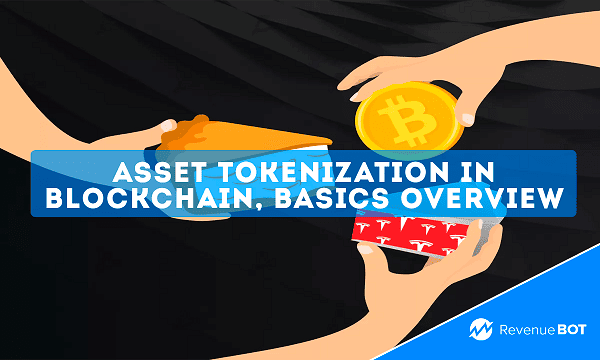
Tokenized commodities usually include energy resources, agricultural products, precious metals and other real-world things. These tangible assets go through a process known as “tokenization,” resulting in ownership rights being converted into blockchain-based cryptographic tokens. Such token represents a share or entirety of the underlying commodity.
Tokenization places a high value on efficiency, divisibility and liquidity, transforming the asset ownership structure. Say, a $10,000 gold bar can be tokenized into 10,000 tokens, which would allow you to carry out transactions easily with no burden of physical storage or delivery.
How does asset tokenization work?
- Tokenization includes dividing the ownership rights of actual assets into digital tokens. As a rule, during this procedure tokens are issued on a blockchain network – exchanges or specialized tokenization platforms.
- Custodianship of the underlying assets is paramount when speaking of tokenized commodities. Such services or smart contracts ensure the secure storage and management of assets, letting tokenholders be comforted to know of asset authenticity and security.
- Once commodities are tokenized, they become prime assets for decentralized exchange (DEX) or peer-to-peer (P2P) trading. Blockchain technology promotes global liquidity and accessibility by facilitating efficient and fair trading. As for smart contracts, these are aimed to ensure seamless transactions while upholding security and trust.
- Tokenholders are still able to exchange them for the underlying physical good. Issuers or smart contracts facilitate this redemption process, which preserves transparency while empowering investors with the freedom to reshape their digital assets into tangible products.
What about the types of tokenized commodities?
- Precious metals such as gold, silver and platinum can be tokenized as well since they allow you to have partial ownership with no need to put it into physical storage. Such a procedure makes these priceless assets more accessible, encouraging hedging and portfolio diversification.
- Oil, natural gas and renewable energy are examples of tokenized energy resources. Here, tokenization breaks down logistical barriers to your investment opportunities in the global energy sector.
- Speaking of agricultural commodities such as beans, corn, wheat and coffee – all these are free to be tokenized either to diversify investor portfolio by providing exposure to the agriculture sector. Once tokenized, they enjoy the potency and comprehensibility of blockchain technology to act as tools for diversification and a hedge against inflation.
- Real estate has grown more affordable through tokenization, which redefines property rights and provides shared ownership and liquidity in the market. Investors can now acquire profitable real estate assets, offering a broader spectrum of investing opportunities.
What are the benefits of tokenized goods?
In the world of blockchain, tokenized commodities provide a number of advantages by utilizing the built-in capabilities (like DLT) and revolutionizing conventional commodity trading.
Fractionalizing commodities into digital tokens improves liquidity by allowing investors to buy smaller units, which expands the market for available investment options. What’s more, because of this fractional ownership, trading and transferability are made simpler, which lowers entry barriers and boosts market efficiency.
Tokenization records ownership and transaction history on an immutable blockchain, thus ramping up transparency and mitigating the risk of fraud. Market players’ trust is still building up for the reason that every transaction is properly audited and meticulously recorded. Due to transparency, the chance of counterfeit goods is lowered as each token has a unique ID so it can be verified right on the blockchain.
In fact, real-time settlement is made possible by tokenized commodities, lowering transaction costs and turnaround times, as well as obviating the need for intermediaries. Smart contracts streamline the settlement process and minimize counterparty risk by being programmed to automatically execute trades upon fulfilling predetermined circumstances.
On top of that, the tokenization process makes commodity markets more inclusive and approachable by enabling investors (who were previously unable to take part in traditional markets due to financial or geopolitical limitations) to embark on trading 24/7 from any corner of the globe as long as they have access to the internet.
What challenges can you face during asset tokenization?
Tokenized commodities are subject to regulation similar to the legal framework applicable to securities, commodity markets and financial instruments, as they often represent tangible assets. To ensure adherence to these standards, one must grasp intricate legal environments and establish strong governance frameworks in order to reduce the risk of scams, bid-rigging and regulatory breaches.
There are plenty of hurdles, including liquidity and market depth. Though tokenization may somehow improve liquidity by allowing for round-the-clock trading and fractionalizing ownership, there is still a stumbling-block to ensuring enough market depth to keep up with large-scale transactions. Liquidity and price discovery in tokenized markets hinge on trust between institutional investors and traditional market participants.
Standardization and interoperability are crucial for a smooth integration with the current financial infrastructure. Speedy settlement and asset transfer are made possible thanks to interoperability, which enables token standards, smart contracts and various data formats to be compatible across various blockchain platforms and commodities markets.
Given that such technology as blockchain is decentralized and unmodifiable, cybersecurity threats are growing more and more in tokenized commodity markets. Adequate cybersecurity precautions like encryption, two-factor authentication (2FA) and ongoing monitoring, are essential in protecting digital assets, private keys and sensitive transaction data against crooks.
